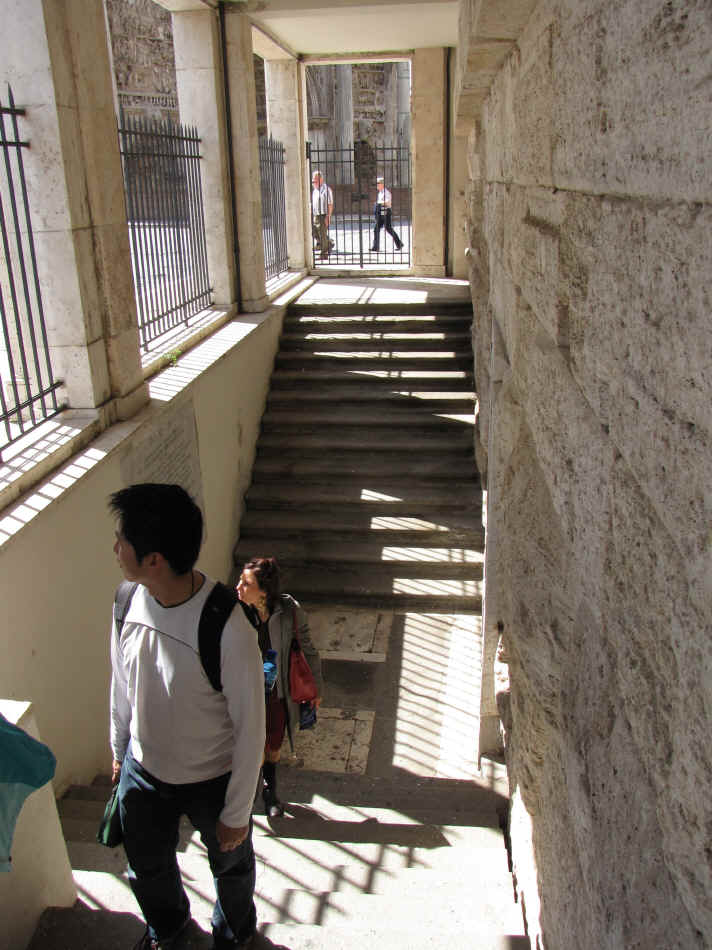
| One of the standard fares for Christian travelers to Rome is the Mamertine Prison. According to tradition, both St. Peter and St. Paul were confined here prior to their executions. The rooms that constitute the upper section and the Tullianum (lower section) surprise most people with how small they are. One has to take into account their customary use though. Imprisonment was not a normal punishment under Roman law. A prison was simply a place to throw the convicted for a day or two until his persecutors could agree on the proper form of death. The closest punishment to imprisonment was slavery which consisted of being sent to a place of work. The Mamertine Prison is located on the south east slope of the Capitoline Hill just above the Roman Forum. |
|
|
|
In the 16th century, the Church of Giuseppe dei Falegnani was built over the Mamertine Prison to consecrate the place of imprisonment of the two saints. That mob was not with us; they were on a tour of the forum. |
|
|
|
Access is allowed only with a paid tour guide. Tour groups are, of necessity, only a few people. The upper room of the prison was built probably in the 2d century BC. It's a single room in a rough trapezoidal shape and was built by stacking tufa blocks. Above a faded fresco still adorns a wall. |
|
|
|
There is an altar set up in the upper room. In the reliquary on top of the altar are busts of Peter and Paul. As can be seen, the roof curves upward from the floor and doesn't leave much standing room in the middle. |
|
|
|
On a brick pillar in the room, this plaque lists in memory the prominent people known to have died here or to have been taken from here to execution. Peter and Paul are at the top of the list. |
|
|
|
The hole in the middle of the floor was formerly the only access to the lower room called the Tullianum. The Tullianum was usually the end of the line. Most people didn't come back out of there alive. |
|
|
|
Today a stairway goes down into the Tullianum. The memorial sign says that the dent in the wall covered by the screen was an indentation caused by the soldiers ramming Peter's head into the wall. |
|
|
| This is the Tullianum. Charming place. Normally there is an altar sitting on that table. It was not present when we visited there and I couldn't get an understandable explanation out of the tour guide for it's absence. The column is a remnant of the flagellation column that was in the room and to which Peter and Paul would have been chained during their confinement. According to tradition, that hole in the floor opened in response to Peter's prayers and a spring of water welled up when he needed the water to baptize his jailers Processus and Martianus whom he converted to Christianity. They went on to themselves becoming martyrs and proclaimed saints by the Church. This circular room was not really built but carved out of the exposed bedrock on the hill. The rock was obviously sliced for flooring and walls but no chance of digging out. |
|
|
|
A marker commemorating the confinement of Peter and Paul and Peter's conversion of the two jailers and the miracle of the spring. |
|
|
|
The Tullianum is truly a morbid place when you consider the history of it. Peter and Paul were the two names that interest Christian pilgrims but the Tullianum had a long list of victims extending back many centuries. This lower portion of the prison dates back to the early 7th century BC. At one time there was a flood gate opening onto an underground channel going to the sewer main. This was opened to dispose of the bodies into the sewer system leading to the river. |
|
|
|
A final look at the Tullianum and we were ready to leave. |
 |
|
Fortunately today there is an outside stairway where our small group could exit out into the sunlight beaming down on the forum. |